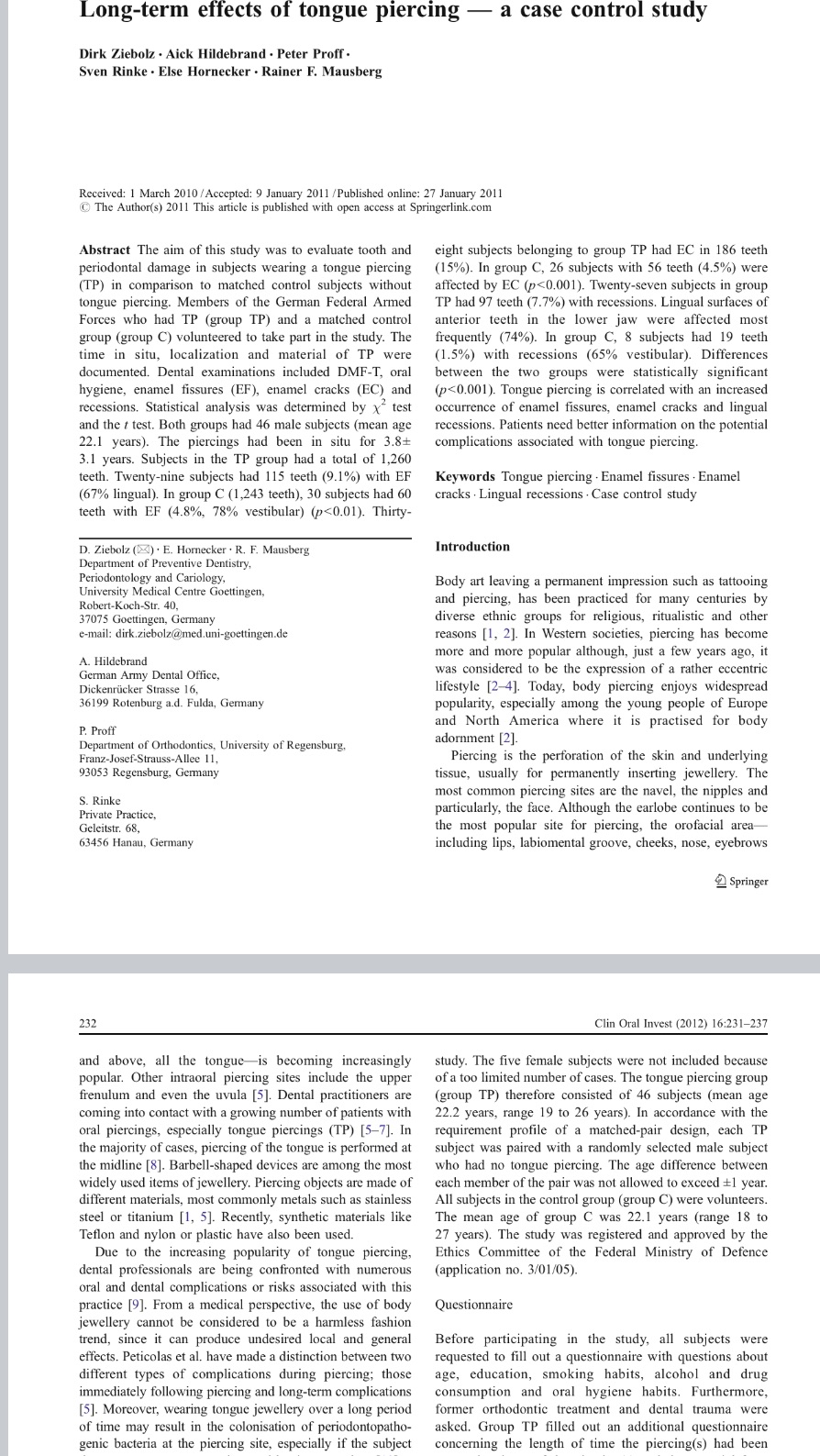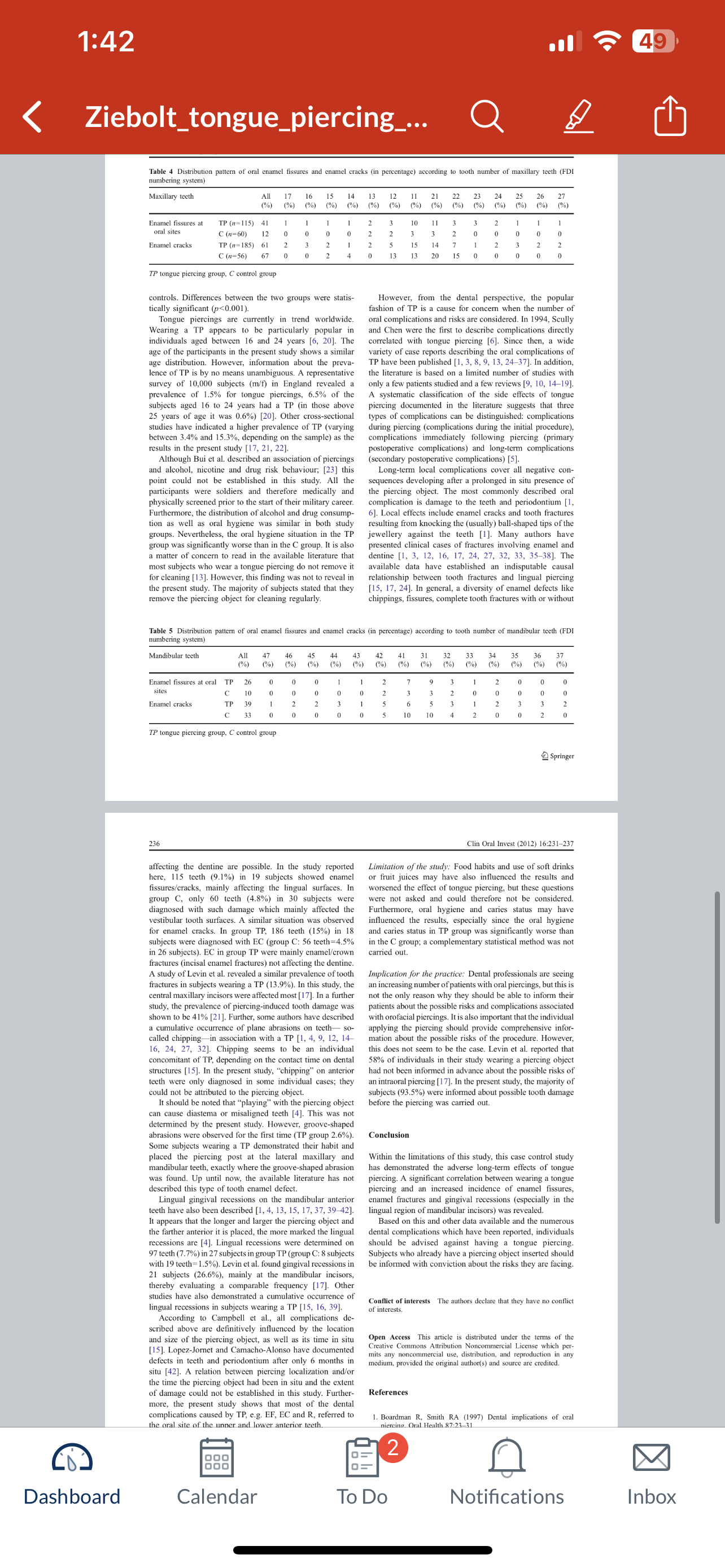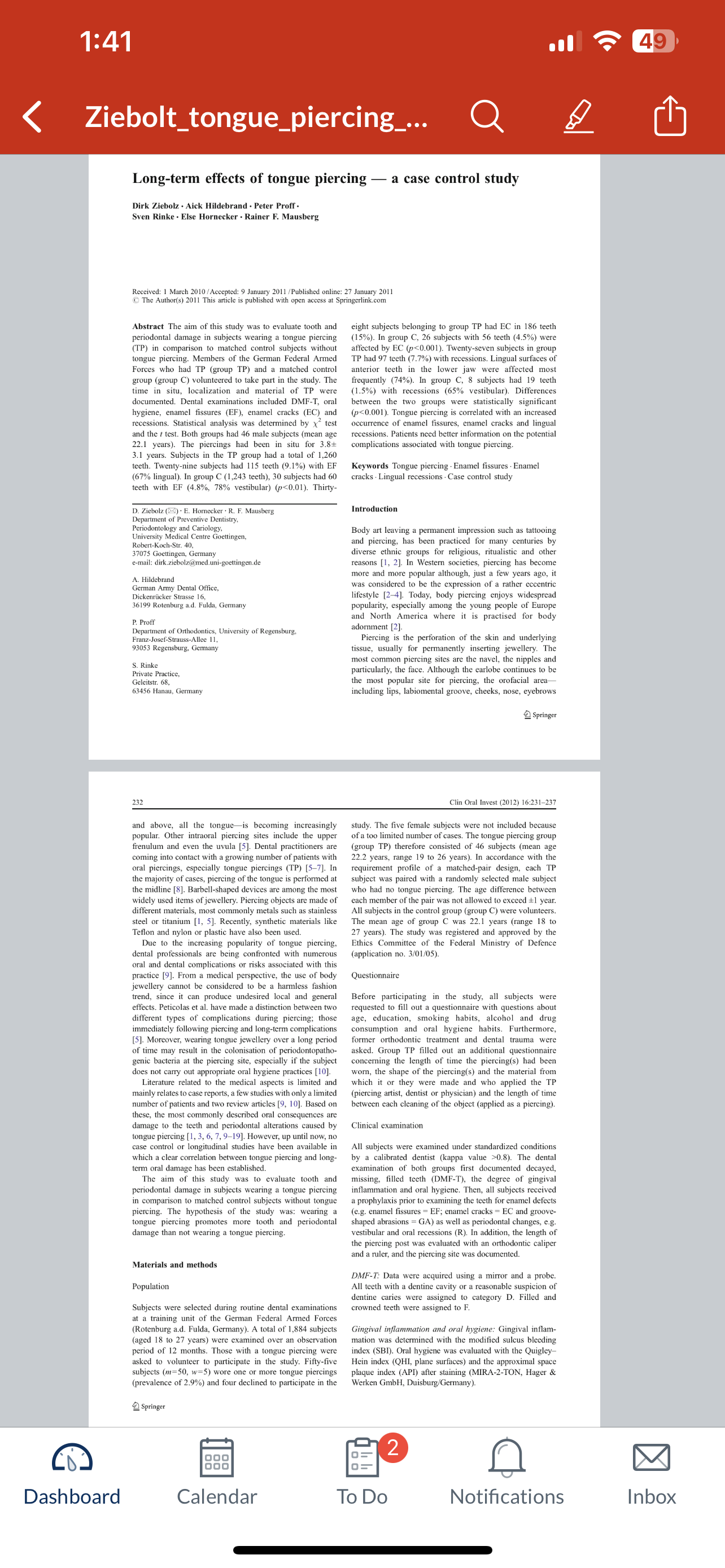Question
Please help with answering practice question 1-4. chapter 18 exercise: A study compared tooth health and periodontal damage in a group of 46 young adult
Please help with answering practice question 1-4.
chapter 18 exercise:
A study compared tooth health and periodontal damage in a group of 46 young adult males with a tongue piercing and a control group of 46 young adult males without tongue piercing. One question of interest was whether individuals with tongue piercing had more enamel cracks, on average. Here are the summary statistics [for the numbers of teeth with cracks]
????n? average ??std dev
tongue piercing ??46? 4.0??? 3.5?
no tongue piercing?? 46? 1.2?? 1.3
chapter 22 exercise:
[Same intro sentence.]
They found that 38 individuals in the tongue-piercing group and 26 in the control group had enamel cracks. Does the study provide significant evidence of an association between enamel cracks and tongue piercing? [Based solely on these data] Can you conclude that there is a causal relationship between tongue piercing and enamel cracks?
The chapter 18 exercises compare the average number of enamel cracks, while the chapter 22 exercises use a binary outcome variable, any enamel cracks vs. no enamel cracks. (Although the binary outcome variable data are presented in chapter 22, we can analyze them using methods from chapter 20, as there are only two groups.)
You will need package DescTools to carry out these analyses,
because we only have the summary data for the means
and because we cannot use the normal approximation for the confidence interval
for the difference of two proportions.
Verify that the data Baldi and Moore present are from the"enamel cracks" columns in Table 3 in the Ziebolt et al. paper.
1. Explain why we can use the t distribution to answer the chapter 18 questions. (Why is the t test for these data robust?) For the summary statistics with the continuous outcome, carry out the test Baldi and Moore suggest, using TTestA (with var.equal = F of course). Also use TTestA to find a 95% confidence interval for the difference of the population means.
Answer Baldi and Moore's question about evidence of causation.
2. For the binary outcome, show that the conditions to use methods based on the normal approximation for a test are satisfied but that the conditions to use the normal approximation method to find a confidence interval for the difference of the population proportion are not.
Carry out the normal approximation test with a one-sided alternative hypothesis (the proportion of cracks in the population with tongue-piercing is higher).
Use BinomDiffCI with the Agresti-Caffo method to find a 95% confidence interval for the difference of the population proportions.
The typical meaning of a case-control design is that samples are taken from the population with the outcome of interest (such as young men having teeth with enamel cracks) and a population that does not have the enamel cracks (young men with no enamel cracks) and then comparing the proportions in each sample with various exposures. The aflatoxicosis in Kenya exercise from Bald and Moore is a nice example. (Exercise 20.34 in both the 3rd and 4th editions.)
3. Explain why this is NOT a case-control study.
Having a matched pairs study design usually means that the differences within the pair are analyzed. (We have done several of these for continuous outcomes in this course.) The authors say ". . . each TP [tongue piercing] subject was paired with a randomly selected male subject who had no tongue piercing. The age difference between each member of the pair was not allowed to exceed + / ? 1 year."
4. This certainly balances out the ages, but do you see any evidence in the Results section that the analysis is matched pairs?
Describe how a matched pairs analysis for the number of enamel cracks would be carried out.



 Long-term effects of tongue piercing - a case control study Dirk Ziebolz . Aick Hildebrand . Peter Proff . Sven Rinke . Else Hornecker . Rainer F. Mausberg Received: 1 March 2010 / Accepted: 9 January 2011 /Published online: 27 January 2011 The Author(s) 2011 This article is published with open access at Springerlink.com Abstract The aim of this study was to evaluate tooth and eight subjects belonging to group TP had EC in 186 teeth periodontal damage in subjects wearing a tongue piercing (15%). In group C, 26 subjects with 56 teeth (4.5%) were (TP) in comparison to matched control subjects without affected by EC (p0.8). The dental term oral damage has been established. examination of both groups first documented decayed, The aim of this study was to evaluate tooth and missing, filled teeth (DMF-T), the degree of gingival periodontal damage in subjects wearing a tongue piercing inflammation and oral hygiene. Then, all subjects received in comparison to matched control subjects without tongue a prophylaxis prior to examining the teeth for enamel defects piercing. The hypothesis of the study was: wearing a (e.g. enamel fissures = EF; enamel cracks = EC and groove- tongue piercing promotes more tooth and periodontal shaped abrasions = GA) as well as periodontal changes, e.g. damage than not wearing a tongue piercing. vestibular and oral recessions (R). In addition, the length of the piercing post was evaluated with an orthodontic caliper and a ruler, and the piercing site was documented. Materials and methods DMF-T. Data were acquired using a mirror and a probe. Population All teeth with a dentine cavity or a reasonable suspicion of dentine caries were assigned to category D. Filled and Subjects were selected during routine dental examinations crowned teeth were assigned to F. at a training unit of the German Federal Armed Forces (Rotenburg a.d. Fulda, Germany). A total of 1,884 subjects Gingival inflammation and oral hygiene: Gingival inflam- (aged 18 to 27 years) were examined over an observation mation was determined with the modified sulcus bleeding period of 12 months. Those with a tongue piercing were index (SBI). Oral hygiene was evaluated with the Quigley- asked to volunteer to participate in the study. Fifty-five Hein index (QHI, plane surfaces) and the approximal space subjects (m=50, w=5) wore one or more tongue piercings plaque index (API) after staining (MIRA-2-TON, Hager & (prevalence of 2.9%) and four declined to participate in the Werken GimbH, Duisburg/Germany). 2 Springer 0= 000 0= X Dashboard Calendar To Do Notifications Inbox
Long-term effects of tongue piercing - a case control study Dirk Ziebolz . Aick Hildebrand . Peter Proff . Sven Rinke . Else Hornecker . Rainer F. Mausberg Received: 1 March 2010 / Accepted: 9 January 2011 /Published online: 27 January 2011 The Author(s) 2011 This article is published with open access at Springerlink.com Abstract The aim of this study was to evaluate tooth and eight subjects belonging to group TP had EC in 186 teeth periodontal damage in subjects wearing a tongue piercing (15%). In group C, 26 subjects with 56 teeth (4.5%) were (TP) in comparison to matched control subjects without affected by EC (p0.8). The dental term oral damage has been established. examination of both groups first documented decayed, The aim of this study was to evaluate tooth and missing, filled teeth (DMF-T), the degree of gingival periodontal damage in subjects wearing a tongue piercing inflammation and oral hygiene. Then, all subjects received in comparison to matched control subjects without tongue a prophylaxis prior to examining the teeth for enamel defects piercing. The hypothesis of the study was: wearing a (e.g. enamel fissures = EF; enamel cracks = EC and groove- tongue piercing promotes more tooth and periodontal shaped abrasions = GA) as well as periodontal changes, e.g. damage than not wearing a tongue piercing. vestibular and oral recessions (R). In addition, the length of the piercing post was evaluated with an orthodontic caliper and a ruler, and the piercing site was documented. Materials and methods DMF-T. Data were acquired using a mirror and a probe. Population All teeth with a dentine cavity or a reasonable suspicion of dentine caries were assigned to category D. Filled and Subjects were selected during routine dental examinations crowned teeth were assigned to F. at a training unit of the German Federal Armed Forces (Rotenburg a.d. Fulda, Germany). A total of 1,884 subjects Gingival inflammation and oral hygiene: Gingival inflam- (aged 18 to 27 years) were examined over an observation mation was determined with the modified sulcus bleeding period of 12 months. Those with a tongue piercing were index (SBI). Oral hygiene was evaluated with the Quigley- asked to volunteer to participate in the study. Fifty-five Hein index (QHI, plane surfaces) and the approximal space subjects (m=50, w=5) wore one or more tongue piercings plaque index (API) after staining (MIRA-2-TON, Hager & (prevalence of 2.9%) and four declined to participate in the Werken GimbH, Duisburg/Germany). 2 Springer 0= 000 0= X Dashboard Calendar To Do Notifications Inbox Step by Step Solution
There are 3 Steps involved in it
Step: 1

Get Instant Access to Expert-Tailored Solutions
See step-by-step solutions with expert insights and AI powered tools for academic success
Step: 2

Step: 3

Ace Your Homework with AI
Get the answers you need in no time with our AI-driven, step-by-step assistance
Get Started


